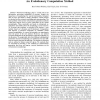Free Online Productivity Tools
i2Speak
i2Symbol
i2OCR
iTex2Img
iWeb2Print
iWeb2Shot
i2Type
iPdf2Split
iPdf2Merge
i2Bopomofo
i2Arabic
i2Style
i2Image
i2PDF
iLatex2Rtf
Sci2ools
IJCNN
2006
IEEE
2006
IEEE
Shaping Realistic Neuronal Morphologies: An Evolutionary Computation Method
— Neuronal morphology plays a crucial role in the information processing capabilities of neurons. Despite the importance of morphology for neural functionality, biological data is scarce and hard to obtain. Therefore, virtual neurons are devised to allow extensive modelling and experimenting. The main problem with current virtual-neuron generation methods is that they impose severe a priori constraints on the virtual morphologies. These constraints are based on widespread assumptions and beliefs about the morphology of real neurons. To overcome this problem, we present EvOL-Neuron, a new method based on L-Systems and Evolutionary Computation that imposes a posteriori constraints on candidate virtual neuron morphologies. As a proof of principle, our experiments show the power of the new method. Moreover, our method revealed a limitation in the description of neural morphology in the literature. We empirically show that Hillman’s fundamental parameters of neuron morphology are satisf...
| Added | 11 Jun 2010 |
| Updated | 11 Jun 2010 |
| Type | Conference |
| Year | 2006 |
| Where | IJCNN |
| Authors | Ben Torben-Nielsen, Karl Tuyls, Eric O. Postma |
Comments (0)

